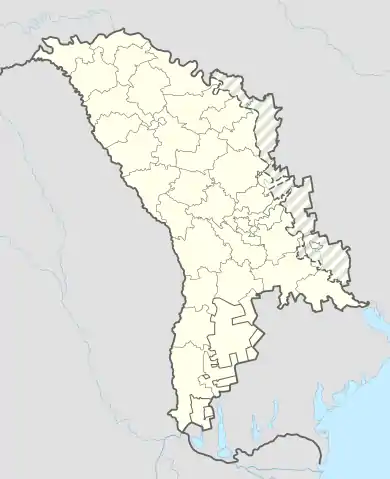Hîncești | |
|---|---|
.jpg.webp) | |
 Flag  Coat of arms | |
 Hîncești Location within Moldova | |
| Coordinates: 46°49′N 28°35′E / 46.817°N 28.583°E | |
| Country | Moldova |
| District | Hîncești District |
| Government | |
| • Mayor | Alexandru Botnari (PDCM) |
| Population | |
| • Total | 12,491 |
| Time zone | UTC+2 (EET) |
| • Summer (DST) | UTC+3 (EEST) |
| Postal code | MD-3401 |
| Area code | +373 269 |
| Climate | Dfb |
Hîncești (Romanian pronunciation: [hɨnˈt͡ʃeʃtʲ]) is a city and municipality[2] in Moldova.
Hîncești is situated on the Cogâlnic River, 33 km (21 mi) southwest of the Moldovan capital, Chișinău. Since 2003 it has been the seat of Hîncești District.
History

Hîncești was established in 1500 AD as Dobreni.[3] [4] Within the Russian Empire it was known under the Russified name Gincheshty (Гинчешты), but in Romanian Hîncești. In 1940 the name was changed to Kotovskoe after Grigore Kotovski, who was born there. But from 1941 to 1944 it was again known as Hîncești. Before WWII, the Jewish community was rather large, in 1930, there were 1,523 Jews living there. In July 1941, Romanian gendarmes murdered more than 100 Jews in a mass execution perpetrated in a trench outside the town.[5]
From 1945 to 1965 it was called Kotovskoe, which in 1965 was changed to Kotovsk. Since 1990 it is again called Hîncești.
Demographics
According to the 2014 census, the population of Hîncești amounted to 12,491 inhabitants, a decrease compared to the previous census in 2004, when 15,281 inhabitants were registered. Of these, 5,824 were men and 6,667 were women.[6]
Ethnic composition of Hîncești (2014)[7]
Footnotes:
* There is an ongoing controversy regarding the ethnic identification of Moldovans and Romanians.
* Moldovan language is one of the two local names for the Romanian language in Moldova. In 2013, the Constitutional Court of Moldova interpreted that Article 13 of the constitution is superseded by the Declaration of Independence,[9] thus giving official status to the name Romanian.[10][11]
In 1890, Hîncești had a stable population of 3,098 citizens. By 1970, the population had increased to 14.3 thousand, and by 1991, 19.3 thousand.
| Year | Pop. | ±% |
|---|---|---|
| 1930 | 6,338 | — |
| 1959 | 8,694 | +37.2% |
| 1970 | 14,201 | +63.3% |
| 1979 | 16,677 | +17.4% |
| 1989 | 19,235 | +15.3% |
| 2004 | 15,281 | −20.6% |
| 2014 | 12,491 | −18.3% |
Education
There are four Lyceum (junior colleges) in Hîncești:
- Mihai Viteazul Lyceum
- M. Lomonosov Lyceum
- Mihai Sadoveanu Lyceum
- M. Eminescu Lyceum
- Timotei Batrinu Scoala de Arte
Notable citizens
- Grigory Ivanovich Kotowski (1881–1925), Soviet military leader and Communist activist.
- Manuc Bei, Very wealthy Armenian merchant
International relations
Twin towns – Sister cities
Hîncești is twinned with:
Notes
- ↑ Results of Population and Housing Census in the Republic of Moldova in 2014: "Characteristics – Population (population by communes, religion, citizenship)" (XLS). National Bureau of Statistics of the Republic of Moldova. 2017. Retrieved 1 May 2017.
- ↑ LEGE Nr. 248 din 03.11.2016 pentru modificarea și completarea Legii nr. 764-XV din 27 decembrie 2001 privind organizarea administrativ-teritorială a Republicii Moldova (in Romanian)
- ↑ Not to be confused with Dobreni, Romania (Latitude: 44° 25' 0 N, Longitude: 25° 7' 0 E).
- ↑ Viorel, Miron (2006) "Managementul resurselor turistice în mediul rural din Republica Moldova" p. 99, doctoral thesis, Economics Department, Universitatea Agrarǎ de Stat din Moldova, Chișinău, in Romanian
- ↑ "Yahad – in Unum".
- ↑ "2014 Moldova Census of Population and Housing". National Bureau of Statistics of the Republic of Moldova. (in Romanian, Russian, and English)
- ↑ "2014 Moldova Census of Population and Housing". National Bureau of Statistics of the Republic of Moldova. (in Romanian, Russian, and English)
- ↑ "2014 Moldova Census of Population and Housing". National Bureau of Statistics of the Republic of Moldova. (in Romanian, Russian, and English)
- ↑ "Hotărâre Nr. 36 din 05.12.2013 privind interpretarea articolului 13 alin. (1) din Constituție în corelație cu Preambulul Constituției și Declarația de Independență a Republicii Moldova (Sesizările nr. 8b/2013 și 41b/2013)" (in Romanian). Constitutional Court of Moldova. Archived from the original on 5 March 2016. Retrieved 20 December 2013.
124. ... Prin urmare, Curtea consideră că prevederea conținută în Declarația de Independență referitoare la limba română ca limbă de stat a Republicii Moldova prevalează asupra prevederii referitoare la limba moldovenească conținute în articolul 13 al Constituției.
[124. ... Therefore, the Court considers that the provision contained in the Declaration of Independence regarding the Romanian language as the state language of the Republic of Moldova prevails over the provision regarding the Moldovan language contained in Article 13 of the Constitution.] - ↑ "Moldovan court rules official language is 'Romanian', replacing Soviet-flavored 'Moldovan'". Fox News. Associated Press. 5 December 2013. Archived from the original on 9 December 2013. Retrieved 7 December 2013.
- ↑ "Chisinau Recognizes Romanian As Official Language". Radio Free Europe/Radio Liberty. 5 December 2013. Archived from the original on 23 September 2016. Retrieved 11 March 2014.